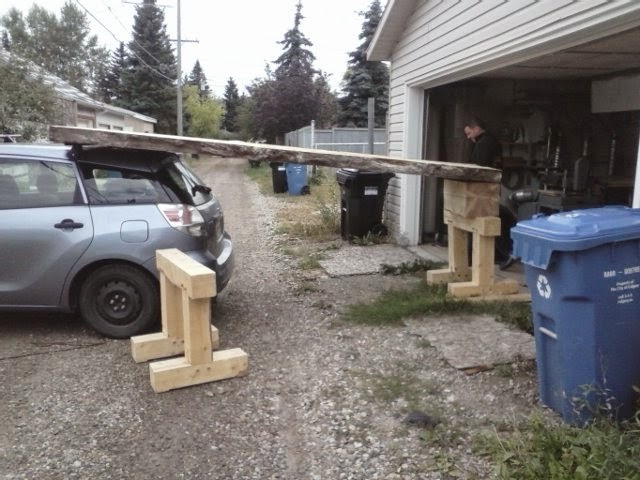I've been puttering along on the Maloof rocker as I've been working on some other projects lately and it is finally finished. The last Post left off with the attachment of the rockers. Since then I've shaped and faired the rockers at both ends and where they attach to the front and rear legs. This was a pretty satisfying step as it really completed the final look of the rockers and tied them into the rest of the chair.
 |
| Closeup of the Ends of the Rockers |
 |
| Closeup of the Rear Leg to Rocker Joint |
 |
| Closeup of the Front Leg to Rocker Joint |
Upon completion of this I went over the chair and sanded out any scratches I could find and brought the chair from crest rail to rockers through 180, 220, and 320 grit. This was a very tedious process as there are so many surfaces which had to be gone over and it is all done by hand. That being said the slow and meticulous nature of the work is alright. This project has taken a long time and bringing it to completion was quite nice.
I rubbed down the entire chair with a microfiber cloth to remove all possible dust from the pores of the wood and clean it up as much as possible before finishing.
I decided to apply Sam's traditional finishing technique to the chair. I have not used this finishing process before but here it is.
There are two stages to the finish.
The first stage uses a mix of
1/3 Boiled Linseed Oil
1/3 Pure Tung Oil
1/3 Oil Based Varnish
 |
| Mix for Phase One |
The second stage uses a mix of
1/2 Boiled Linseed Oil
1/2 Pure Tung Oil
Bees Wax to bring the mixture to the consistency of heavy cream.
Of course that recipe doesn't really say just how much bees wax that means. So I measured the mix before and after the wax and did a little math. Here's what I ended up using.
7 parts Boiled Linseed Oil
7 parts Pure Tung Oil
2 parts Bees Wax
 |
| Mix for Phase Two |
I shaved the beeswax using a carrot peeler and as this took quite a while to make progress tried making small chunks with a knife. This seems to melt into the oil just as well. I heated the mixture in a mason jar in the microwave on low for a minute at a time. After three minutes the wax was completely melted into the oil and I just had to wait for the mixture to cool.
 |
| Turns Out Small Chunks Cut With a Knife Work Well Too |
 |
| Melting the Beeswax Into the Oil |
 |
| The Cooled Wax Has a Tendency to Separate, a Quick Shake Solves the Problem |
The first mix is applied by wiping it on liberally and covering the entire chair, waiting a couple minutes and then wiping off the excess. This is done once a day for 4 days. The second mix is applied using the same technique and is done once a day for 2 days.
 |
| Partway Through Applying the First Coat of Finish |
 |
| Partway Through Applying the First Coat of Finish |
 |
| After Applying the Third Coat |
 |
| After Wiping Off the Excess of the Third Coat |
Going forwards I think I will change the finishing process. I would finish it with the first wiping
mixture, completing 4 or 5 coats, and omit the second mixture (I found it quite sloppy) in favor of applying a simple paste wax or beeswax.
The way I see it, the first mix is an application of oil and varnish; simplifying a bit, the oil seeps into the wood and the varnish builds on the surface. After a few coats of this I am unsure how effectively the oil was still passing through the varnish and wonder how much of it I was just wiping off. There was an accumulation of waxy residue from the second mix which I buffed to a smooth finish.
After applying finish daily for a week I was anxious to get the chair out of the shop and have a sit; thankfully it is quite comfortable! Following are a few shots of the rocker's first day out in the sun.

















































